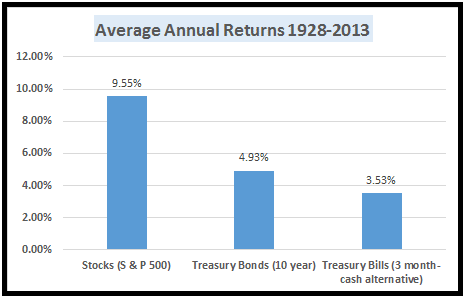Asset Classes Matter
In a previous article, I received the following comment, which inspired me to answer the question, “Is a 7% future long term return achievable?”
Little House commented:
“I like how you broke down the asset classes percentages of stocks and bonds. Do you really think we can expect an average return of over 7 percent over the next 30 years? My husband and I were just discussing how savings rates are so low and have been for 10 years. We remember when we were kids in the 80′s that they were up to 12 percent! We can’t fathom them returning to this rate any time soon. Of course, savings rates aren’t the same as stock returns, but still. Am I being to gloom-and-doom? Will we see these returns again? I hope so!”
How are Stock Market Returns Created?
Economic growth is propelled by innovation, commerce, and invention. Economic growth advances corporations and leads to higher stock prices.
Click here if you want to solve your investing problems.
Here’s how it works:
- A company creates products and services.
- Individuals and other companies buy these items.
- Eventually the goods and services may be sold internationally.
- The company makes more money and gets bigger.
- As the company grows, they purchase more from others just as others are buying from them.
- Then, the company sells shares (ownership in their firm) to the public and the stockholders can participate in the profits (losses) of the company.
- Investor’s benefit from growing companies by purchasing stock (and bond) investments from the company. Mutual funds or ETFs that hold growing companies allow investors to participate in the growth.
- The investors make money 2 ways. First, as the firms sales and profits increase, the stock price also goes up. Second, the company may pay out some of its net income to the shareholders in the form of dividends.
This is the stuff that “economic growth” is made of.
Growing companies create more wealth in the participating economy. With globalization, its easy for those in Europe or the U.S. to benefit from growing companies in Brazil or India.
Smaller companies can grow faster than larger ones. And smaller (developing) countries can grow faster than larger ones.
Is a Seven Percent Future Return Possible?
Assume you have asset classes in your investment portfolio consisting of stock and bond index mutual funds (or ETFs). Make certain to include some international index funds as well. Diversify the international funds with holdings from developed and emerging markets.
Diversified asset classes in the portfolio increase overall return while keeping risk to a minimum.
Consider these questions and answers to determine whether a 7% investment portfolio is possible in the future.
Will interest rates on bonds and cash increase in the future? It’s likely that interest rates will rise since they are at a historical low point.
Will China, India, and Brazil continue to grow rapidly in the future? There is little evidence to suggest their rapid growth is over. These emerging markets (and others) with quickly growing economies will offer higher stock market returns than the slower growing countries.
Will European and North American markets continue to grow? As long as these developed markets continue to innovate and grow goods and services available for consuming and exporting, they will expand.
Rationale For a Future 7% Long Term Return
I am not a soothsayer, but if I had to predict; the world economies’, over the long term will expand. Will they falter at some points? Absolutely economic growth will falter, economic growth is cyclical. From 2007-09 the U.S. had a recession. In 2014-15 the Eurozone is struggling economically.
Recently, the U.S. has experienced several years of stock market growth, so don’t be surprised when investment returns go down at some period in the future.
Interested in building long term wealth? Then click here and learn the smartest way to invest.History has rewarded those who invested in stocks and bonds. If you have more than ten years until you need your investment funds, and world markets continue to grow, a balanced allocation in diversified asset classes of stocks and bonds representing various size companies from around the world could very likely reward you with a 7 percent annualized return.
Be aware that although long term stocks delivered higher returns, there is no guarantee about the future.
And if you’re looking for higher returns on cash, eventually interest rates will increase. And when they do, so will returns on cash assets.
If you hold an investment portfolio with both U.S. and International stock index funds, bond index funds and a bit of cash, it’s possible to obtain a long term 7% rate of return. If historical returns continue, and you hold 65% stock assets, 30% bonds, and 5% cash, and historical returns continue into the future, then your return average annual return would be 7.86%.
Now, in response to the original question, “Is a 7% long term return achievable?”- with a diversified portfolio, yes. With only cash investments, t’s unlikely to obtain a 7% average annual return.
For reference, here are long term rates of return for various asset classes:
Action Steps:
1. Invest in your workplace retirement account today. It is the easiest way to invest and build wealth.
2. For speedy asset growth-invest the maximum amount allowable by law into your workplace retirement account (or a Roth IRA) in a portfolio of diversified asset classes.
3. Rebalance the asset classes allocations every year.
Do you believe a future 7% return on a balanced portfolio is plausible?
a version of this article was previously published


